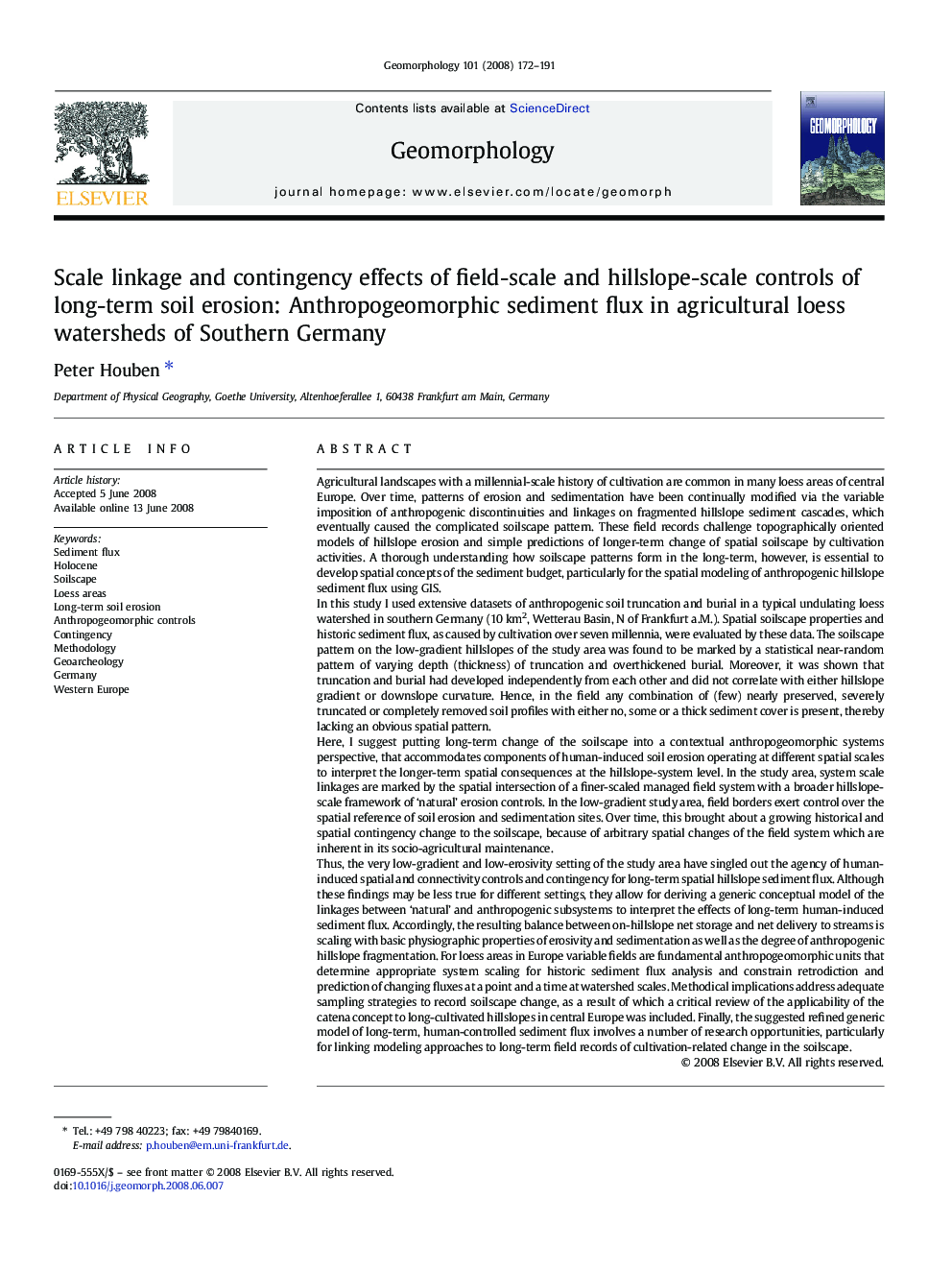| کد مقاله | کد نشریه | سال انتشار | مقاله انگلیسی | نسخه تمام متن |
|---|---|---|---|---|
| 4687002 | 1635552 | 2008 | 20 صفحه PDF | دانلود رایگان |

Agricultural landscapes with a millennial-scale history of cultivation are common in many loess areas of central Europe. Over time, patterns of erosion and sedimentation have been continually modified via the variable imposition of anthropogenic discontinuities and linkages on fragmented hillslope sediment cascades, which eventually caused the complicated soilscape pattern. These field records challenge topographically oriented models of hillslope erosion and simple predictions of longer-term change of spatial soilscape by cultivation activities. A thorough understanding how soilscape patterns form in the long-term, however, is essential to develop spatial concepts of the sediment budget, particularly for the spatial modeling of anthropogenic hillslope sediment flux using GIS.In this study I used extensive datasets of anthropogenic soil truncation and burial in a typical undulating loess watershed in southern Germany (10 km2, Wetterau Basin, N of Frankfurt a.M.). Spatial soilscape properties and historic sediment flux, as caused by cultivation over seven millennia, were evaluated by these data. The soilscape pattern on the low-gradient hillslopes of the study area was found to be marked by a statistical near-random pattern of varying depth (thickness) of truncation and overthickened burial. Moreover, it was shown that truncation and burial had developed independently from each other and did not correlate with either hillslope gradient or downslope curvature. Hence, in the field any combination of (few) nearly preserved, severely truncated or completely removed soil profiles with either no, some or a thick sediment cover is present, thereby lacking an obvious spatial pattern.Here, I suggest putting long-term change of the soilscape into a contextual anthropogeomorphic systems perspective, that accommodates components of human-induced soil erosion operating at different spatial scales to interpret the longer-term spatial consequences at the hillslope-system level. In the study area, system scale linkages are marked by the spatial intersection of a finer-scaled managed field system with a broader hillslope-scale framework of ‘natural’ erosion controls. In the low-gradient study area, field borders exert control over the spatial reference of soil erosion and sedimentation sites. Over time, this brought about a growing historical and spatial contingency change to the soilscape, because of arbitrary spatial changes of the field system which are inherent in its socio-agricultural maintenance.Thus, the very low-gradient and low-erosivity setting of the study area have singled out the agency of human-induced spatial and connectivity controls and contingency for long-term spatial hillslope sediment flux. Although these findings may be less true for different settings, they allow for deriving a generic conceptual model of the linkages between ‘natural’ and anthropogenic subsystems to interpret the effects of long-term human-induced sediment flux. Accordingly, the resulting balance between on-hillslope net storage and net delivery to streams is scaling with basic physiographic properties of erosivity and sedimentation as well as the degree of anthropogenic hillslope fragmentation. For loess areas in Europe variable fields are fundamental anthropogeomorphic units that determine appropriate system scaling for historic sediment flux analysis and constrain retrodiction and prediction of changing fluxes at a point and a time at watershed scales. Methodical implications address adequate sampling strategies to record soilscape change, as a result of which a critical review of the applicability of the catena concept to long-cultivated hillslopes in central Europe was included. Finally, the suggested refined generic model of long-term, human-controlled sediment flux involves a number of research opportunities, particularly for linking modeling approaches to long-term field records of cultivation-related change in the soilscape.
Journal: Geomorphology - Volume 101, Issues 1–2, 1 October 2008, Pages 172–191